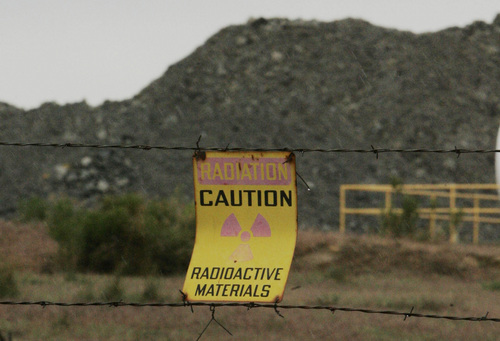This is an archived article that was published on sltrib.com in 2014, and information in the article may be outdated. It is provided only for personal research purposes and may not be reprinted.
Just as the nation's last remaining uranium mill is about to win permission to process waste from a Washington state Superfund site, government documents suggest the Utah operation has been emitting radon gas in excess of federal standards and "fugitive" dust has blown off site.
Grand Canyon Trust is citing these documents, filed in recent months with Utah regulators, in a lawsuit it is preparing against Energy Fuels Resources, the Colorado-based uranium producer that operates the White Mesa Mill six miles south of Blanding.
One of the mill's five impoundments, constructed to permanently hold processed ore, released too much radon last year, according to a formal notice the trust sent the company Wednesday. The letter is giving company executives 60 days' notice that it will sue in Utah's federal court to enforce the Clean Air Act.
The trust also contends Energy Fuels is operating too many impoundments at one time and that two exceed the size limit by a few acres.
"If we are going to have milling on the Colorado Plateau, it needs to be in strict compliance with laws to protect environmental and public health," said Anne Mariah Tapp, the trust's lawyer.
Company officials declined to discuss the trust's latest allegations because they are the subject of pending litigation.
"The issues raised by this group are either inaccurate, have been addressed, or are being addressed as part of the normal regulatory processes," spokesman Curtis Moore said. "Energy Fuels and the regulators are well aware of these matters, none of which has resulted in a violation."
The mill produces uranium oxide, better known as yellowcake, which utilities refine into nuclear fuel to generate electricity. Energy Fuels processes conventional uranium ore it mines in Utah and Arizona, but it also accepts tailings from sites across the country. Each time it secures a source of "alternate feed" it must persuade the Utah Division of Radiation Control to modify its permit.
The state agency is finalizing not only Energy Fuel's permit renewal, but also its modification to allow it to process and dispose of tailings that would be trucked from the Midnite Mine outside Spokane.
Citing declining uranium prices in the wake of the Fukushima reactor meltdown, Moore said Energy Fuels will suspend mineral processing in mid-2014 and resume operations next year.
"There is still going to be quite a bit of activity at the mill," Moore said. "We have permit compliance. We have to manage our inventory. We will still accept materials for future processing."
He expects the company will deliver 800,000 pounds this year to its three customers, all utilities obligated to buy White Mesa yellowcake at prices far higher than the $35 a pound it is currently fetching on the spot market. Global demand for this product is about 160 million pounds a year, almost a third going to U.S. utilities.
Grand Canyon Trust has long opposed Energy Fuels' plans to mine and process uranium on the Colorado Plateau, particularly in areas north of Grand Canyon National Park. And Ute Mountain Ute tribal leaders, who represent the White Mesa community three miles to the south, have also voiced concerns.
Mill operations "pose serious threats to the health of the land and the natural and cultural resources within and around the tribe's White Mesa community and to the health and welfare of its tribal members and their future generations," officials wrote in their comments on the mill's application for a renewed permit.
At the request of the tribe a few years ago, the U.S. Geological Survey investigated the possibility of radionuclides migrating off site. In its 2011 report, the agency's scientists reported elevated levels of uranium and vanadium in plant tissue collected from sagebrush downwind of the mill.
It also found high uranium concentrations in groundwater samples taken from downwind ephemeral drainages. Plant and water samples taken upwind yielded concentrations consistent with what occurs naturally.
Uranium and other elements release radon as they decay. Although the gas occurs naturally, radon exposure is the second leading cause of lung cancer, blamed for about 20,000 deaths annually. Federal law on hazardous pollutants — the National Emission Standards for Hazardous Air Pollutants, or NESHAP — sets limits on radon emissions at 20 picocuries per cubic meter per second.
In 2012, Energy Fuels reported to the Utah Division of Air Quality that emissions from White Mesa's Cell 2 impoundment averaged nearly 26 picocuries. The company initiated plans for regular monitoring and corrective action and the radon emissions have since trended downward. Last December, emissions amounted to 10 picocuries, but averaged over the year, the emissions still breached the federal threshold, according to Grand Canyon Trust.
The mill's five disposal cells cover 275 acres, but Energy Fuels owns 5,415 total acres, setting up a buffer extending a mile or two in every direction.
Grand Canyon Trust's lawsuit would ask the court to impose a fix on the mill's impoundments, as well as civil penalties. While the company contends it is operating only two impoundments at once in compliance with federal law, the trust argues it actually has at least four open if you count a nearby pond, which contains overflow from one of the cells.
"Until that final cover is on Cell 2, the same problem is going to occur over and over again. There is a simple solution. We feel this notice was the most effective way to ensure a final solution," Tapp said. "The agencies have limited resources and there are times that critical environmental problems and threats to public health are occurring."



